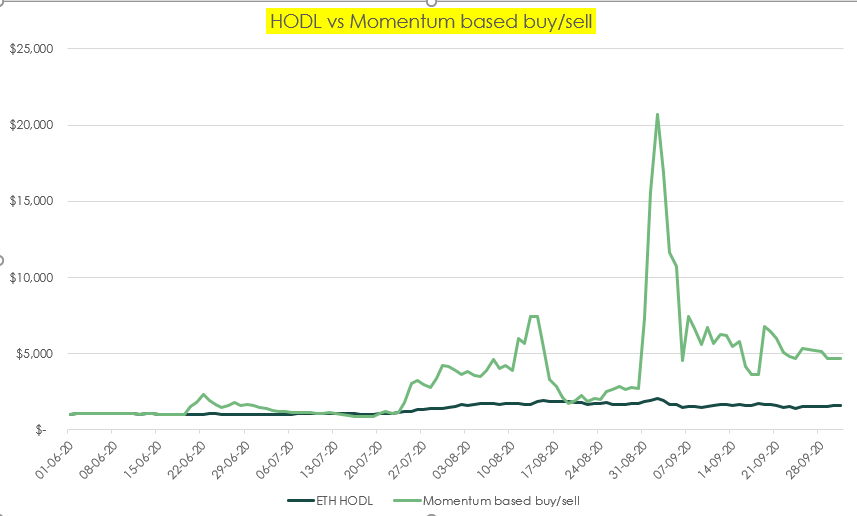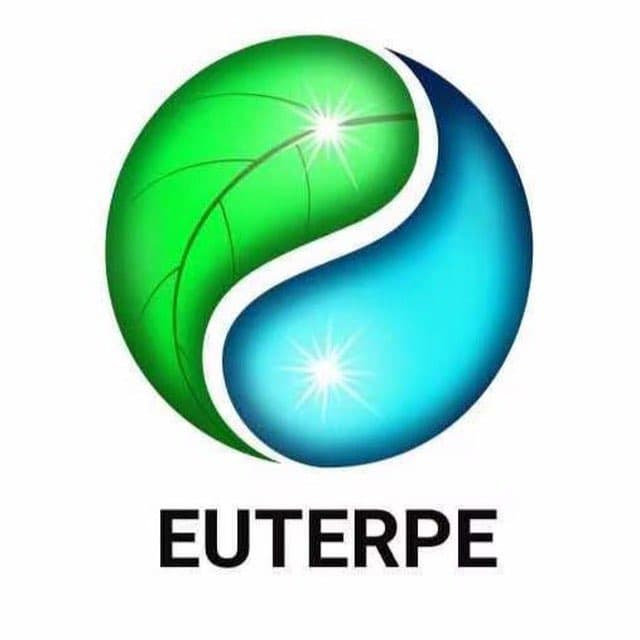Co-authored by Eric Choy, CFA, Strategist at PANONY, and Saurabh Deshpande, Digital Assets Research, B&B Analytics|SEBA
Executive summary
● We carried our backtesting of three broad investment strategies in DeFi – HODL ETH, Buy/Sell governance tokens, and Yield farm governance tokens
● Higher fees prevent smaller investors from participating in yield farming. Though large investors are better off yield farming, successful yield farmers needs to be highly knowledgeable and must commit the entire time to it
● Based on multiple considerations such as risk-adjusted returns with bitcoin as the reference, knowledge and sophistication required, and time commitment from investors we think that buying and selling governance tokens with moderate risk management would have been the best strategy
Abstract
In this article, we evaluate the performance of different DeFi portfolios. We test three different approaches – hold ETH as it is the major asset that gives exposure to DeFi, buy/sell governance tokens of different DeFi platforms, and ‘earning’ governance tokens through yield farming. Within buy/sell, we test three different strategies: momentum-based, rules-based, and DeFi Degen.
Teaser
DeFi has been a strong driving force for the digital assets’ narrative this summer. Within DeFi there are multiple investment strategies one could adopt. We analyse the performance of different strategies in this digital investor and conclude that active buying and selling of governance tokens was the best strategy instead of just holding ether or yield farming.
Introduction
In the third quarter of 2020, decentralized finance (DeFi) seized a major mind share of the cryptoasset industry. With billions of dollars on public blockchains, the intuitive next step is to generate yield on those idle assets through an on-chain credit system aka the blockchain banking layer. What happened in DeFi this summer is a step ahead in an experiment to transform banking on the blockchain. DeFi is tinkering with different financial products right from borrowing and lending to derivatives. Currently, this movement is largely enabled by the Ethereum blockchain as it offers compossibility needed for different money legos to interact with each other.
Governance of these new money protocols is a major challenge and currently, governance token is the most popular solution. This token allows holders to vote on various proposals and entitles them to a share in profits of the protocol in some cases. Compound protocol ushered in a norm where the governance token is distributed through a mechanism called liquidity mining wherein the protocol distributes its governance token to users based on their share of liquidity in the protocol. Tokens earned through liquidity mining can be thought of as the yield and therefore liquidity providers (LPs) are also known as yield farmers.
Yield farming activity gave way to a new investment theme in the digital asset ecosystem. Fundamentally, there were three distinct strategies to participate in this investment theme. In this article, we analyse and compare all of them. These are:
1. HODL – passively holding ether (ETH)
2. Buy/Sell DeFi governance tokens – Momentum-based, DeFi-Degen mentality, or Rules-based approach.
3. Yield farm governance tokens
We analysed these strategies over four months from June 1, 2020, to October 1, 2020.
Three investment strategies
Figure 1 shows the different strategies we compare in this article.

HODL ETH
The HODL ETH strategy consists of holding ETH through the four months. Buy and hold is a time-tested investment method that has worked over longer periods. We use this strategy as a benchmark to verify whether there is any merit in more actively managed strategies.
Yield Farming
Another popular way to participate in the DeFi ecosystem is yield farming or liquidity mining as we have stated in our previous Digital Investor. A significant advantage of yield farming over the buy/sell strategy is that investors can provide liquidity in pools such ETH-stablecoin so that they are not swapping ETH or stablecoins for new tokens that are yet to prove their mettle.
Buy/Sell Governance Tokens
The buy/sell DeFi governance tokens strategy is a generic name that encompasses three different ways to trade tokens: (a) DeFi Degen, (b) Rules-based, and (c) Momentum-based buy/sell.
- Degen, short for degenerate, is a term popular on crypto twitter (CT) to address those who switch from one DeFi token to another in a matter of days or even hours in some cases. As we have noticed through this summer, several people invested money into projects that barely had a website let alone a reputable team or a whitepaper. A DeFi Degen is someone who only chases momentum due to FOMO (fear of missing out). DeFi Degen represents an investor who buys the narratives on CT. Notice that if not within the insider DeFi circles, having a sound technical understanding of the protocols is non-trivial. So as stated before, this type of strategy would be purely predicated on hype, FOMO, and spun up narratives. Degen trading is at the end of the trading risk spectrum where risk management is absent.
- On the other end of the spectrum, the rules-based approach is calculative. For this analysis, we decided that one buys when the price crosses 50% of the listing price or the latest low and sells when the price is 30% down from the peak.
- The momentum-based strategy is a bit subjective with a balance between the rules-based approach and DeFi Degen. However, we believe that it stays true to chasing momentum by continuously looking at Twitter and other digital relays. It is not as calculative as the rule-based approach but still adheres to selling when the price drops by approximately 30%. This strategy has a simple premise. How would a portfolio look like if one would just HODL versus actively seeking out alpha returns in a market with no fundamental or technical driven valuations.
We considered the following tokens for these strategies: BAL (Balancer), COMP (Compound), CRV (Curve DAO Token), LEND (AAVE), SUSHI (SushiSwap), UNI (Uniswap), YAM (yam.finance) and YFI (yearn.finance). The basis for these tokens were that they were discussed the most in the DeFi circles and were amongst the heavily traded within DeFi.
Comparison of three methods within the Buy/Sell governance token investment strategy
To start our analysis, we imagine an investor with a capital of USD 1,000. The returns for three different methods are a stunning 1978% for Rule-based investment, a mere 66% for Degen and a healthy 365% for momentum-based investment. The only reason the Degen portfolio has a 66% return is due to the UNI airdrop . Figure 2 illustrates the performance of different strategies.
Note that the major difference in three different buy/sell strategies is due to the price performance of YFI. A rules-based approach would not have sold YFI to chase YAM as the former had not dropped by 30% from the peak and the latter had not risen by 50% of its listing day close. However, had the threshold been different (say 20%), the investor might have swapped YFI with YAM. Also, YAM plummeted from USD 138 to almost worthless in just over one day. A DeFi Degen would have lost the entire portfolio due to the YAM fiasco.
Fig 2. USD 1000 investment and 3 strategies

Source: SEBA Research, Coingecko, PANews
The return of the rules-based strategy is driven predominantly by the meteoric rise of YFI price from 0 to USD 40,000 and then settling around USD 30,000 in about 2 months.
Even though the rule-based strategy outperformed the other two, it was extremely difficult to execute. Nobody could have known that YFI would reach USD 45,000 within days after they purchased it at approximately USD 1,500. The most likely scenario is that they would have sold it for a handsome 6X within a month to chase the momentum further with other governance tokens.
While DeFi Degen (high risk) and the rules-based approach (low risk) are at the two ends of the risk spectrum within buy/sell strategies, the momentum-based strategy poses a moderate risk. And the momentum-based strategy was relatively easier to execute compared to the rules-based approach. If we remove the hindsight-bias, an investor was likely to chase momentum with moderate risk management. Therefore, we think that the momentum-based method best represents the buy/sell governance tokens strategy.
Portfolio performance of HODL ETH vs Momentum-based buy/sell investment Strategies
When we analyse the performance of USD 1,000 invested in these two strategies, the momentum-based strategy outperforms holding ETH by approximately USD 3,100 or 310%. Each buy and sell would be conducted as a swap on UNISWAP with UNISWAP’s ERC20-ERC20 fees taken into consideration. In the simulation, these fees did not have much of an impact. But this portfolio was a recipient of the UNI airdrop. We assume if one is holding only ETH, they would not have received UNI airdrop and it makes a difference of USD 1,661 in the final portfolio value.

Source: SEBA research, Coingecko, PANews
It is important to note that from the days that were decided to buy and sell into another DeFi token, a 24-hour deviation from that day would not have made that much of a difference with the exception of YAM. If the DeFi Degen portfolio held their YAM position for another day into August 14th during the crash, they would have an ending portfolio value in the low double digits.
HODL portfolio has a final value of USD 1,548 and while the momentum-based portfolio has a final value of USD 4,648. The Sharpe ratios of the two portfolios with bitcoin as a benchmark are 10.1 and 13.1 respectively.
While the momentum-based strategy offers a superior return compared to HODL, the strategy lost all its advantage twice versus the passive holding one. It means that to fully capture the advantage of this active strategy, the investor must be disciplined and available all the time.
The rest of the analysis is continued on Part 2.
(1)UNI, the governance token of Uniswap DEX, was airdropped to all the addresses that had interacted with the Uniswap exchange at least once before September 1, 2020










